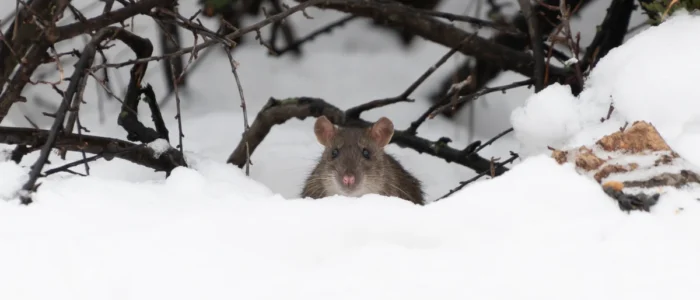Winter doesn’t slow rats down as much as many would hope. Instead of hibernating, they seek warm, hidden spaces to escape freezing temperatures. Rats respond to their environments, so their behavior changes with the seasons. However, they always follow food, warmth, and access.
Rodents seeking shelter will wriggle their way into whatever type of hideout they can find, including your car. But it’s not just your car you should worry about. Rats’ natural instinct is to survive, so if they can’t find a perfect car shelter, they will seek refuge in crawlspaces, attics, or garages.
Can Rats Survive in the Cold?
Rats can survive the cold, but they prefer not to. Rats are adaptable and resourceful. While their natural burrows and nests can hold warmth, prolonged exposure to freezing weather drives them indoors. They will burrow under foundations, into compost bins, or beneath sheds to get below the frost line. However, man-made environments are far more appealing.
Rats can survive outdoors in winter if they have deep enough shelters and a steady food source, but these conditions are harder to find in urban and suburban settings. As a result, rats look for better alternatives and often find them in garages, warehouses, and wall cavities. They might also follow heat along utility lines or enter buildings through gaps near pipes and vents.
Rodents & Vehicles
Rodents view vehicles as perfect winter hiding spots. Engine bays retain heat, and tight spaces make them feel secure. When a car hasn’t been used for several days, it becomes even more inviting.
A rat’s slender body is shaped in a way that allows them to slide through holes the size of a quarter. That means there are plenty of entry points into your vehicle, such as steering columns and vents. Rodents will move into your car to find food and shelter from the cold winter. As car manufacturers find more eco-friendly materials to use in cars, rodents find even more to chew on.
Rodents chew to manage the growth of their teeth, and car wiring offers a soft, chewy texture. It’s not just annoying; it can be costly. Damage to ignition systems, sensors, and cables often leads to repairs in the hundreds or thousands of dollars.
Rats build nests using insulation, fabric, leaves, or plastic inside air filters or behind panels. Once inside, they often leave behind droppings and urine, creating both a mess and odor. Frequent vehicle use helps, but it’s not always enough to stop them from trying. Parking in garages, sealing off entry points around garage doors, and checking under the hood regularly can help discourage nesting.
If you spot signs of a rodent infestation in your vehicle, consult a local mechanic about the issue. You should also consider partnering with a pest management professional to ensure the infestation does not spread from your car to your home.
Rodents & Homes
Rats choose homes because they offer everything they need during winter. Wall cavities, attics, and basements are all common nesting areas. From there, it’s a short trip to food sources like pantries, trash bins, or pet food containers. Once they’ve built nests, they don’t leave on their own. If food and water are present, rats will raise their young indoors, worsening the problem as winter continues.
Houses with cracks around the foundation, loose siding, or open vents are at higher risk. Rats only need a hole the size of a quarter to squeeze through. Once inside, they gather nesting materials like paper, insulation, cloth, or cardboard to build their nests in quiet, dark corners. Their presence can bring noise, damage, and the risk of contamination.
Rodents & Businesses
Commercial buildings can be just as attractive to rats as homes. Warehouses, restaurants, and food-processing facilities offer shelter and an often-overlooked food supply. Even non-food businesses attract rats through trash bins, employee breakrooms, or open loading docks.
Larger structures offer more entry points, making them harder to secure without a plan. For businesses, that often means working with professionals who can help identify and seal those entry points using exclusion tactics.
Rats in businesses can cause structural damage, chew wiring, and create health risks for staff and customers. This can also damage your reputation quickly in environments like restaurants or retail stores. Rats will burrow into insulation or hide behind stacked inventory, making them hard to detect until the signs are obvious.
Quick prevention tips
The most effective way to keep rats out is to make sure your property doesn’t offer easy access to food, warmth, or water. Our first prevention tip is to store food in sealed containers, keep garbage areas clean and inspect the perimeter of your building for holes or gaps. If a rat can feel warm air from a crack, it will likely try to enter.
Keeping outdoor vegetation trimmed and away from walls reduces hiding spots. Installing brush or rubber door seals keeps rodents from slipping under doors. Avoid leaving out pet food or letting clutter pile up in basements and storage rooms. Rats love quiet, cluttered spaces that offer plenty of shelter. Consistent maintenance and awareness are key.
Understanding how rats behave in winter and how they adapt to colder weather helps explain why infestations rise during colder months. They don’t stop moving when the weather drops; they just move indoors. Whether it’s a home, a car, or a business, rats follow the same need for warmth and food. Taking steps early in the season and staying alert to warning signs can make your property less inviting during their search for winter shelter.
For more information on rodents, please visit Smarterpestcontrol.com.

